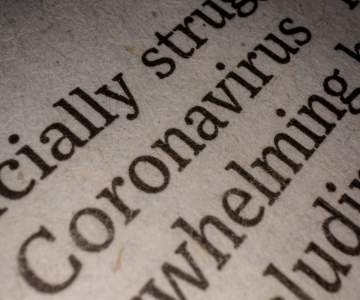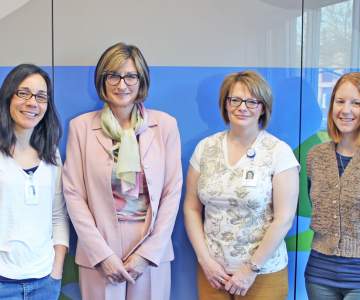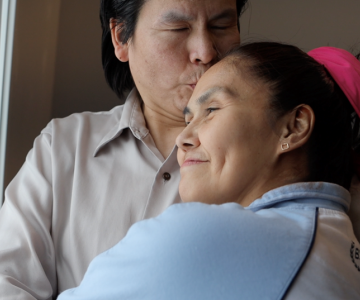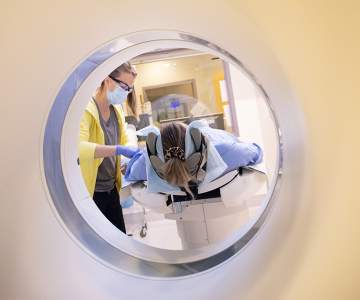Breadcrumb
Explore Stories
2 Minute Read
Health & Wellness
Expanded access to specialized care and reduced travel key benefits for patients and caregivers
New research from the UBC Southern Medical Program (SMP) supports the use of telehealth in the care of Parkinson’s patients in rural communities, particularly within the Interior Health region.
The treatment of Parkinson’s disease is highly complex and relies heavily on a patient’s changes in their physical features over time, such as the rigidity of muscles and movement of limbs. As these characteristics can vary significantly between patients, personalized treatment plans must reflect individual circumstances and other lifestyle factors.
Fourth-year SMP student Dakota Peacock and lead author of the new study underscores the need for Parkinson’s patients to have access to quality health care regardless of the size and location of their home community.
Within the B.C. interior’s vast and mountainous landscapes, lengthy travel times and hazardous road conditions, especially during the winter months, can provide additional barriers to patients and their caregivers. Additionally, the COVID-19 pandemic has led to a dramatic increase in the need for virtual health care options to support patients remotely.
“The focus of our study was to gain a deeper understanding of the challenges faced by Parkinson’s patients within Interior Health region in accessing specialized care,” says Peacock. “We also sought to assess their potential willingness to use telehealth technologies in supporting their health and well-being.”
Dr. Daryl Wile, neurologist with the Okanagan Movement Disorder Clinic and study co-author, acknowledges the effectiveness of telehealth in Parkinson’s care is yet to be established. However, he believes certain aspects of physical exams are less critical in follow-up appointments and could be delivered remotely.
“To use telemedicine for people with Parkinson’s Disease we need to understand how we can adapt the tools we have to the many different types of symptoms they may be facing,” says Wile, clinical assistant professor with the SMP based at UBC Okanagan.
Based on the survey results, 80 per cent of respondents indicated a willingness to use telehealth for follow-up appointments as part of their Parkinson’s treatment. Key challenges reported including difficulty accessing specialized care closer to home and the financial and emotional toll of travel on caregivers or family members.
“It’s encouraging that we could potentially minimize some of the barriers and stressors for Parkinson’s patients in accessing care, but fully recognize there is no one-size-fits-all approach,” adds Peacock.
The UBC study was recently published in the Canadian Journal of Neurological Sciences.
This article was originally published in UBC Okanagan News.
4 Minute Read
Community & Culture
We are IH is a recognition campaign to spotlight Interior Health employees and medical staff – through pictures and stories.
To help us celebrate National Nursing Students Week, we met with Mariah Perry, a recent 2019 graduate from the Practical Nursing Program at Okanagan College. As part of the incredible team at Kelowna General Hospital, Mariah stands out for her big heart, her desire to spread kindness, and her positive attitude. At first, Mariah may be shy but before you know it she is filling the room with her radiating energy!
Inspired by her desire to make a difference in the lives of others by working closely with them, she pursued a rewarding career as a Licensed Practical Nurse. As she was starting her career, the COVID-19 pandemic began, creating completely new challenges for everyone to navigate. We are so proud to see all of our health-care heroes rise to the occasion and continue to provide the best possible care amidst the pandemic.
Mariah Perry in PPE
Mariah reflects on the growth she has experienced throughout the pandemic.
“I feel for the patients in the hospital, especially with visitor restrictions, but it has been something special to me, as I have had the opportunity to be there for my patients. It’s been inspiring to see us come together to get through this pandemic. Everyone motivates me, and it shows how we are stronger together and we’re not alone.”
In the dynamic field of nursing, some days are better than others, but at the end of the day, you can end your shift with a sense of pride. Mariah shares one of her proudest moments at IH as she comforted a palliative patient. They shared meaningful conversation about life and he told her she was the nicest nurse he has ever had, really touching Mariah's heart. It's moments like these that make it all worth it.
“I love nursing because there is so much room to grow in this career. Right now, I do really love bedside nursing and the medical floors I work on, but I have the option to expand my knowledge in so many ways when I want to and I think that's amazing!”
Mariah Perry and her Grandfather
From a young age, her family has been extremely influential in her life. Mariah’s grandfather ingrained in her his favourite quote as a child: “Always forward, never back.” These words have helped propel her forward during tough times and encourage her to persevere towards a solution. She fondly remembers her grandfather’s quote regularly to quickly move from worry to action forward.
Young Mariah and her sibling
Surrounded by the natural beauty of the four seasons, Mariah feels extremely grateful to be born and raised in Kelowna, her forever home. Growing up as “Mariah Perry” she was surprisingly asked if she was named after the famous, Mariah Carey, and also blessed with her vocals. Despite a short stint in singing lessons, Mariah has concluded it did not help her singing abilities and no one wants to hear her sing.
You can find Mariah out shooting hoops playing basketball with her friends or taking on a DIY craft. Mariah knows how important self-care is, especially during these times in her career, so makes time to incorporate physical activity into her crafts to keep her mind in the right place.
The pandemic has shown us what's important and not to take anything for granted. Mariah looks forward to a time where hugs can be given out freely, quality time can be spent with family and friends, and all of the added stress can be removed from everyone’s life. Thank you for all that you do, Mariah! You have a very successful career ahead of you and we are honoured to have you at Interior Health.
Check back each Friday for the next We are IH feature.
For more information contact EmployeeExperience@InteriorHealth.ca.
Mariah's nomination of Mary Lynn Pallett keeps the We Are IH loop going:
Mary is an LPN on 6 West and she is the absolute best! Her nickname is Mamma Lynn, she has such a big heart and really looks out for everyone on the unit!
2 Minute Read
Health & Wellness
Have you ever heard the phrase "if you want to make a change in the world, start by changing yourself"?
Widespread change might seem difficult to achieve, but it's possible if we decide to do things differently.
If you want to fight addiction and stigma, and help end overdose, here are three easy steps to follow:
End stigma. Words have power. We can end stigma around substance use and people who use drugs by changing our language. Take the Addiction Matters Kamloops Every Word Matters pledge today.
Educate yourself. Visit stopoverdose.ca, which is home to many engaging articles, blog posts, videos and important resources. This provincial site is managed by the Ministry of Mental Health and Addictions and is a great “one stop shop” for information that can also be easily shared.
Have a courageous conversation. Prepare ahead and then talk with someone close to you about substance use and the overdose crisis. Honest conversations bring the issue of substance use and addiction from society’s shadows out into the light – and reaching out to someone to talk can make all the difference.
Facebook Contest
Interior Health and Addiction Matters Kamloops want to encourage as many people as possible to take these small steps.
You can make a difference in the world and win a great prize in the process!
Follow Interior Health on Facebook to enter the contest between Nov. 22-28. Simply comment and share the Interior Health Facebook post about National Addictions Awareness Week, and share your personal commitment.
Prizes include a copy of “Chasing the Scream” book about addiction; a Starbucks gift card, and a beautiful framed print from the Addiction Matters Kamloops Photo Voice project. Winners will be randomly chosen on Nov. 30 and notified through Facebook.
National Addictions Awareness Week is Nov. 22 -28. This year’s theme builds off previous campaigns to end stigma by declaring “Change Begins with Me”. Interior Health and its partners at Addiction Matters Kamloops invite you to consider the way you think about substance use and take action this week to learn more about addiction, fight stigma, and help end overdose.
3 Minute Read
Health & Wellness
In the midst of ongoing dual public health emergencies, a new app has been launched to prevent overdose deaths in B.C.
Lifeguard Digital Health CEO Jeff Hardy was inspired to develop the application after losing a friend to a fentanyl overdose. Launched in May 2020, the app has continued to gain popularity among people who use drugs and those who support them.
The concept is simple: Once downloaded on a mobile device, the app is activated by the user before they take their dose. After 50 seconds the app will sound an alarm. If the person using the app doesn't hit a button to stop the alarm, indicating they are fine, the alarm grows louder and if the individual does not respond the app will trigger medical assistance.
Peer outreach has played a significant role in encouraging people to try the free Lifeguard app. Kelowna’s PEOPLE Employment Services has been providing hands-on tutorials about installation and use. Peers showing Peers how to download and use the app makes a big difference. Kelowna now has one of the highest numbers of people downloading the Lifeguard app in BC.
“It was a perfect fit with what we were already doing in the community,” says Executive Director Dhorea Ramanula. “We were seeing and hearing about a lot of folks who were feeling lonely and isolated due to COVID-19. Being alone and using drugs, especially now, is a dangerous combination and we wanted to do more to save lives.”
One Peer involved in promoting the Lifeguard app in the Kootenay region is Frank, who works as an advocate and identifies as an empowered drug user. Frank has personally used the app several times and describes it as a “kick-ass resource” that is well-designed, particularly for people who are using drugs alone due to shame and blame that so often accompanies substance use.
Frank says for some people using the app can be a first step to reintroducing self-care.
“It’s a way I can take care of myself. Any way I can get into self-care is positive, and the app is a simple way to do that. Once I switch from cloaking myself in shame to saying ‘I’m going to do this little thing to take care of myself’, everything changes. Nothing about my drug use changes, but actually everything changes, because I’m saying ‘I’m worth it. I deserve to live’. It can be a tipping point from ‘this is a shameful, dirty secret’ to ‘it’s ok for me to protect myself.’ And then that can develop into ‘I’m going to brush my teeth’ and ‘I’m going to talk to my care provider.”
“I can’t overstate the power that has.”
The Lifeguard app is expected to help address overdose rates among people who use drugs alone - the group at the highest risk of fatal overdose.
The Lifeguard app is continuing to improve since its initial launch. It now includes access to additional crisis lines as well as guides to perform CPR and deliver Naloxone.
“There are a number of reasons why people choose to use their substances alone, and while we encourage people to ideally access an overdose prevention site, or use with someone who can administer Naloxone, the Lifeguard app is a safeguard for those people who don’t have those options available to them,” says IH Substance Use Practice Lead Amanda Lavigne.
“You can drastically change the outcome of your use. Because it is incredibly risky,” says Frank.
To learn more visit www.lifeguarddh.com.
2 Minute Read
Did you know that health care careers are high in demand? These careers include a range of professions from administrative to nursing to social work and everything in between. With a variety of professions to start a career in, there is something for every skill set! The time is now to make a change a become a health care hero at Interior Health.
How do I start a career with Interior Health?
On Tuesday, November 24th, 2020, from 10 AM PST to 2 PM PST, Interior Health is hosting a virtual career fair for a variety of professions. This is your opportunity to learn more about Interior Health, how to start a career in a specific profession and virtually meet our team. You can chat directly with our team to have all of your questions answered and make connections.
What is a Virtual Career Fair?
Change has been the only constant this year. As we all adjust to the new normal amidst this pandemic, we have pivoted to hosting our own virtual career fair. Similar to past career fairs you will learn about Interior Health, job opportunities, and talk directly with our team of recruiters to help guide you through the application process.
Which careers are being featured?
Our team will provide an overview of Interior Health as an employer, our regions, and speak directly to the careers outlined below. If you are interested in careers outside the ones presented you can simply sign up for general inquiries to connect with the right team member.
How do I prepare for the virtual career fair?
All you have to do is register for the virtual career fair and attend!
Here are a few tips for best practice that can help you stand out: Connect with IH on Social
Facebook: @IHJobs
LinkedIn: @InteriorHealthAuthority
Instagram: @InteriorHealthBC.Careers
Explore career opportunities at Interior Health
General Website
Aboriginal
Social Work
Critical Care Nursing
Medical Device Reprocessing
Medical Laboratory
Cook & Support Services
Nursing
Pharmacy Careers
Surgical Operating Nurses
Administrative
Physicians
Questions?
We are happy to help! Please email careers@interiorhealth.ca for all inquiries.
16 Minute Read
Community & Culture
When news broke that Interior Health had recorded its first positive case of COVID-19, health-care professionals braced themselves for the unknown. In February 2020, very little was known about this novel virus except for reports about what was happening in other countries where hospitals were being overwhelmed with patients.
As new information began streaming in on almost an hourly basis, health-care teams across Interior Health stepped up to adapt new processes and procedures on the fly.
Despite feelings of uncertainty and fear, a sense of camaraderie and a determination to protect the population swept over the health-care community.
Here are the stories of the people at Royal Inland Hospital who were called upon to take on a task where the outcome was unknown and where their own lives could be in jeopardy. Their experiences reflect what was happening in health care across Interior Health.
On working at Royal Inland Hospital during the COVID-19 public health emergency in spring 2020:
Tracey Rannie, executive director, clinical operations
I had the privilege of leading a diverse and confident team of individuals who brought a wealth of experience and expertise to the table during this pandemic. Working in health care and having a background in nursing, I understand first-hand the daily risks you take when working in a hospital setting. However, working through a global pandemic was on a different scale for the team at Royal Inland Hospital.
Initial fear of the unknown and the long hours required to quickly implement procedures and changes that would normally take many months proved difficult and trying for everyone. However, it was a great opportunity to show our support for one another and to display our strength of teamwork. Royal Inland rose to the challenge and was able to continue providing quality patient care and ensuring the safety of our staff.
I am forever grateful for the outpouring of support from the Kamloops community as well, who supported the health-care community by sending words of encouragement via letters and cards, band tributes and drive-by salutes to name a few.
Dr. Elizabeth Parfitt, infectious disease specialist
“Initially, there was the fear that you experience being a health-care worker and community member during this time. For many of us that fear peaked when we heard about the first positive test – knowing that the virus that has been all over the news is now here in our community affecting our patients and residents of our communities.
Then you move into that acceptance phase and really focus on what needs to be done to minimize the impact. That was the period when the creative energy came in. This was why we all went into health care in the first place and we were ready to rise to the challenge. This was the exciting, energetic and collaborative phase of the whole thing. It was all about how do we do this. That’s when we saw the rapid shift from implementing processes that usually takes a long time in the health-care system to getting something to happen quickly in response to an immediate need.
We realized that we could change things here right here right now and that resulted in intense creativity that was grounded in practicality, based on what we know about other respiratory viruses. We saw a lot of team effort from other teams throughout the hospital. That’s where we get that war time language, like rising to the challenge. We were figuring it out as we went, but also being practical.
We got over that initial fear – though it comes back in waves – and even though there was the risk of being exposed to cases, we knew and accepted that we had to do what we had to do.
At the same time, we saw amazing support from the community – there were parades by the hospitals, signs of support and nightly banging of the pots across the city. That was really meaningful – that recognition by people of what health-care teams were being asked to do – it was so helpful to get the effort going to take on this virus.
The creativity and reorganization happened across the community as well. Look at all the changes that businesses have had to make, learning about infection control and other safety measures to protect their clientele and their employees.
Of course, the economic impact is very significant and now the work is to try to strike a balance where we optimize health outcomes while trying to protect people’s livelihoods, education, and the need for social and physical connections, all of which are also critical to health.
And now we are waiting to see if there will be a second wave, but we know what to do now and we are ready.
The majority of people have bought in. They’ve seen the graph of Spanish influenza and they are prepared to make the sacrifices required to stop transmission if we have increased transmission in the fall.”
Kamloops This Week: Kamloops doctors applaud public’s response to COVID-19 - “We have seen incredible buy-in locally,” said Dr. Elizabeth Parfitt, infectious disease specialist at Royal Inland Hospital
CFJC Story – Local doctors express gratitude for community vigilance in the midst of COVID-19
Heather McIntyre, pharmacy technician
“I was 25 weeks pregnant when the pandemic ‘hit’ us at RIH. Initially, there was a lot of fear and feeling of uncertainty of what was to come, for me, not only what my workplace would look like, but what it meant carrying a child into what could potentially be a hot spot for the virus.
The hospital and my department started to get into a routine and things began to feel under control in the following weeks. I had a great deal of support from my supervisors, ensuring I felt safe and knew I had the option to stay home if I felt I needed to keep my distance from this potential hot spot.
I chose to continue working everyday partly because I feel strongly about patient care, but also the strong sense of team and community that has come out of the pandemic. I really wanted to be part of team that was helping to conquer COVID and showing up to work every day to do my part was a way to achieve that.”
(Heather’s baby was born in July.)
Stacie Andriashyk, registered dietitian
“I have a mix of feelings about work during the pandemic. Especially at the beginning of the pandemic, there was a lot of fear of all the unknowns. We did not know the impact the coronavirus would have on our community and our health-care system – and fearing the worst. There’s fear of not having enough personal protective equipment. There’s fear of bringing the coronavirus home and getting my family sick, but as well fear of being a carrier and passing the virus onto my patients.
It’s heartbreaking to see limitations on visitors, particularly when a patient is very sick or dying. I see how patients don’t do as well in the hospital when they don’t have their family members present helping to care for them, encouraging them to eat and being there to hear all the information coming at them from the health-care team.
I feel amazement at how quickly everyone in the organization worked to put in place protocols and safety measures to protect staff and patients to the best of their abilities.
I feel inspired by the level of commitment, dedication and bravery of all the frontline workers at RIH who continue to show up and deliver quality care during the pandemic.
I feel grateful to have my health, to have my job and to be able to come to work and help out in these times.”
Justin Fournier, registered nurse, High Acuity Response Team (HART)
“Pandemic. What does that mean? Who goes where? What do we do? How do we protect ourselves?
How do we protect our families? Or patients? Chaos. Questions. So many questions. Answers start to filter in and then it started to sink in. This pandemic was happening whether we liked it or not.
Without knowing it, we have been training for this pandemic our whole careers, now we must begin to work together more than we ever have to overcome public and our own fears.
Trust your training, protect yourself…we will survive.”
Jacqueline Pelton, professional practice leader, pharmacy
“We learned about the virus early in the year and, at first, we assumed it would have only a small impact on our hospital services.
However, as we learned more about the virus and its impact, practices in the hospital changed very rapidly and continued to change day-by-day. Very rapid change was needed to limit the spread of the virus, both in in our community and in the hospital.
Initially, some pharmacy staff at the hospital became ill with the virus, but luckily, they recovered well. Other pharmacy staff were sick with colds so they had to stay home until they were confirmed COVID negative. While the pharmacy was short staffed, the remaining pharmacists and technicians worked extra hard to provide medications and pharmaceutical care to patients in hospital so they could recover.
Pharmacy technicians continued to deliver medications to all wards and the clinical pharmacists continued to provide ward-based pharmaceutical care to patients, albeit with masks and PPE. Our outpatient pharmacists who usually dispensed oral chemotherapy, parenteral antibiotics and HIV meds to patients at the hospital shifted their practice to sending their medications to patient homes directly via courier and counselling their patients over the phone.
We, like many hospitals across Canada, experienced pressures on our essential medications during the pandemic. For example, our supply of propofol (a medication used to sedate patients on ventilators), ran low due to supply challenges from manufacturers and the rapid increase in COVID patients who needed ventilators in the ICU. This was very worrisome. But thanks to the diligent efforts of our pharmacy purchasers and regional pharmacy teams, we were able to maintain sufficient supplies of propofol for our patients here at RIH. Regionally, our hospitals pharmacy departments, formulary coordinator and purchasers collaborated wonderfully to share essential medications between sites, based on which facility needed them most.
The pharmacists, technicians and purchasers at RIH Pharmacy displayed great courage, resilience and teamwork during the pandemic. Despite all the challenges the pandemic presented, RIH Pharmacy Staff provided high-quality pharmaceutical care to the patients of Kamloops.”
Deb Donald, Aboriginal patient navigator
Deb Donald, Aboriginal Patient Navigator sets up to do a Face Time session for a family to visit a patient in hospital remotely during the COVID-19 public health emergency
“Unfortunately, during COVID-19 family members could not come into the hospital to see their loved ones. However, we were gifted IPads so that we could at least do FaceTime sessions to allow patients and families to stay connected.
This also allowed family members to see what it was like for frontline health care staff to take care of their loved ones. Donning all the personal protective equipment was taxing. Nurses and doctors were also able to provide updates to families via FaceTime, which also allowed family members to ask questions.”
Kennedie Maidment, registered nurse, intensive care unit
“By signing up to work in health care, you know that you will be coming face to face with contagious pathogens on an almost daily basis. This has proven true in my short three years thus far as an ICU RN. However, never did I expect to come face to face with a pandemic, especially one like COVID-19 with no known treatments – curative or protective.
Uncertainty and constant change have been the only consistencies so far while we navigate working through this. Daily emails containing updates and policy changes, the new addition of a surgical or N95 mask to my uniform, and increased time spent on the phone or FaceTime with families who can no longer visit in person, are just a few of the changes to my practice.
However, working through this pandemic has not been all bad. I have never seen our team become closer and adapt to changes so quickly.
I'm so thankful for the positive light of my co-workers and the good nature we've all kept up through this time. On behalf of my co-workers and myself, we wish everyone far and wide to stay healthy, stay safe, and stay sane.”
Charlotte Killick, occupational therapist, intensive care unit
“It was pretty scary to start with. There was this virus that we knew existed and everything we knew about it we knew from SARS.
I was three months in my first occupational therapy job ever and already had Imposter’s Syndrome of not feeling confident that I knew my job. Then we added a virus and I really didn’t know what was going on, and no one else did either.
Tackling this virus and all the changes we had to make fostered a degree of camaraderie on the Intensive Care and Step Down units. We were all listening to the experts and we realized even the experts didn’t fully understand what was coming. We had to trust what we were learning, the medicine and the needs of our patients. And a lot of the fear kind of went away. We just did the job we got into health care to do.
At some point I stopped feeling like an imposter and began to feel that I knew my job and what was needed of me at any given time.
At first, I was feeling pretty afraid. I tried to put on a brave face with my co-workers, but I started seeing more and more red on the door, which meant that was a hot patient. One day I needed to work with a patient, but I was too scared to go in, so the physio and the nurse went in and I waited the outside the door in case they needed a third pair of hands. I tried to rationalize that I was hanging back because we had to preserve the personal protective equipment, but deep down, I know it was because I was too afraid and that any other time I would have been in the room with them.
And the next day it was the same patient, same scenario and we needed three people in the room. This time, I didn’t let my fear hold me back. From then on, it was jumping in off the deep end. I wasn’t afraid like that anymore.”
Shanta Rishy-Maharaj, emergency department manager
Shanta. At the time this photo was taken in June 2020, masks were worn by health-care workers providing direct patient care and otherwise instructed to practice physical distancing. Today, masks are required in all B.C. health-care facilities.
“There was a lot of anxiety at first. People heard about nurses and doctors dying in other countries and then suddenly we were dealing with the virus here. I was in Toronto during the SARS crisis so I saw firsthand what can happen to health-care workers.
We knew we had to respond quickly for things like physical distancing measures for our patients, including where they waited and how they were transported. We were really busy during the first two weeks changing processes and protocols, even though visits to the Emergency Department were down.
As a manager, I heard our nurses concerns and we talked daily about personal protective equipment and how to stay safe. Naturally, there were lots of questions about that at our daily meetings. People were concerned about taking this illness home to their families. Our triage nurses are the first people who see patients when they come to the hospital and we had to make sure they felt safe and were properly protected.
The pandemic was declared while the flu season was under way and we were dealing with lots of respiratory illnesses. It was good practice for our teams to take all the right precautions because you can’t know immediately who might have COVID-19 and who has a simple cold.
It was impressive, though, how quickly we did introduce all the changes and how our whole team rose to the challenge and embraced the idea that they were there to care for sick people regardless of the illness.”
Shannon Atwater, dietetic technician/supervisor
“The Food Services team at Royal Hospital consists of a large number of skilled and dedicated staff working a wide range of positions. When we first learned of COVID-19, our initial feelings included uncertainty and anxiousness about the unknown
There was so much to learn as well. There were group meetings, constant streaming of information through various channels and getting that information out to staff. We also had to reassure staff and ourselves that we were going to be OK.
We also implemented new protocols quickly. We acquired new personal protective equipment for all staff and we asked our team to accept the change, trust the process and go forward together.
It was amazing to see the unfaltering dedication, compassion, co-operation, patience and kindness shown not only by our staff but from all staff throughout the entire hospital.
Through it all we continued to provide delicious, nutritious and visually appealing meals to all of our patients at RIH as well as at Ponderosa and Hillside too. ‘It takes a village’ was our motto, along with the provincial health officer’s reminder to be kind, be calm and be safe.
We developed a sense that if we can make it through this, we can make it through anything. I am very proud of our team as part of the collective at Royal Inland Hospital.”
Pamela McClelland, physiotherapist, intensive care unit
“There was uncertainty at the beginning and there was a new change or announcement each day. That was quite stressful, but during it all the physio department really came together as a team. Staff who had been out of acute care practice were redeployed when outpatient areas closed and they were mentored and supported by the acute care therapists.
I had just begun a rotation in ICU at the beginning of March. It was a challenge learning in a new clinical area at the same time adjusting to the changes that happened in ICU to prepare for increased demand.
I think the ICU team did a great job preparing for what could have been.”
Steve Waring, Deb Cosgrove-Swan, Samantha Schneider, infection control
During any outbreak, the Infection Control Team in a hospital is called upon to alleviate staff fears and educate them on the illness and how it is transmitted. That responsibility amplified significantly when the COVID-19 pandemic was declared.
At the time this photo was taken in June 2020, masks were worn by health-care workers providing direct patient care and otherwise instructed to practice physical distancing. Today, masks are required in all B.C. health-care facilities.
Team members also had to deal with a few worries of their own when they saw the devastating impact the virus was having on the health-care system and health-care workers in Italy. Deb was pragmatic with many years of nursing experience and a long-held belief that the biggest threat to humans would always be a bug (virus).
Their first task was to make sure hospital staff knew this was not an airborne illness, but was transmitted by droplets. Some people erroneously thought they could get sick just from walking into the building.
There was a lack of trust initially because information was changing daily, even twice a day. The team reminded people that figuring out how to deal with this new virus was a moving target and everyone would have to move with it. Staff members understood and accepted that approach.
They talked to staff about safety, personal protective equipment and the proper use of space. They were also involved in reconfiguring the Emergency Department so potential or test-positive COVID-19 patients were physically separated from other patients. A lot of education was necessary so all staff working in a small space understood how to stay staff and how to keep their patients safe from the transmission of the virus.
Deb Cosgrove-Swan retired a year ago but has worked since that time to fill vacancies. Did she ever consider returning to retirement full time when she saw what was happening with COVID-19 in other countries? Not for a second.
“You don’t nurse for 47 years in infection control to miss out on this.”
3 Minute Read
Community & Culture
This year has brought significant change around the globe, including a pandemic at our doorstep that has required all of us to adjust to the new normal. Very quickly our health care workers selflessly showed up committed to protecting and serving their communities in these uncertain times, including our health care heroes, Nurse Practitioners (NPs).
It isn't without the help of the entire team that we can strive towards providing exceptional patient care. We are honoured to celebrate Nurse Practitioners week and show our gratitude and appreciation for the vital role our NPs play in our organization.
"My role provides access to care that patients may not otherwise take part in, and I provide a broader perspective to the team. I can look at health issues beyond diabetes to help support patients in their health journey. I am able to refer them to Specialists and order diagnostic test if needed."
- Kim Hayter, NP IH Diabetes Program, Kelowna, BC
Our Nurse Practitioners (NPs) improve timely access to high-quality and cost-effective care throughout our diverse communities. With their advanced education and clinical experience they are able to access the patient needs, order and interpret diagnostic and laboratory tests, diagnose disease, formulate and prescribe treatment plans.
Nurse Practitioners throughout or rural and urban areas of Interior Health continue to show up amid a global pandemic to keep their patients healthy and safe. Thank you for all that you do!
Our Health Care Heroes
Our very own health care hero and Nurse Practitioner, Donna Gibbons, was honoured with the BC Health Care Award for her work in her community. This video on Donna's work is an incredible representation of the positive impact she is having on her patients.
Donna Gibbons awarded BC Health Care Award for work in her community.
What makes Donna [Gibbons] special is she really cares about her patients, she goes the extra mile, she doesn't leave a stone unturned. She always works to find the best way to care for someone that meets their needs."
Andy Smith - RN at Slocan Community Health Centre
Donna Gibbons with patient at Slocan Community Health CentreDid you know?
1. NPs work with, rather than replace, other health-care providers. They are part of a collaborative team that includes registered nurses, doctors, social workers, and others. – Learn more here
2. 93% of Canadians are confident that NP’s can meet their day-to-day health needs. – Learn more here
3. An estimated 3 million Canadians receive primary care from a Nurse Practitioner, estimating around 800 patients per NP. – Learn more here
“The thing that struck me the most when I started working with a Nurse Practitioner was just a sense of relief from shared responsibility. As a practitioner prior to working with an NP, I was very isolated, almost lonely, working in a bit of a silo. I had relationships with other physicians and other care providers but not that kind of collaboration that exists in real-time in working with an NP.”
- Blair Stanley, IH Physician in Trail, BC
Nurse Practitioner Careers
At Interior Health, we offer a diverse range of career opportunities for Nurse Practitioners such as Acute Care (Cardiac Surgery, Thoracic Surgery, Hospitalists), Specialty Clinics (Diabetes, Atrial Fibrillation, Renal), Long-Term Care, MAiD, and Primary Care.
As varied as the practice sites are from urban to rural and remote, so too are the models of care from shared care; to collaborative practice; to solo practice; to inter-professional team-based care. Whether you are seeking an urban centre or the peace and tranquility of rural living, we offer opportunities to suit your lifestyle.
Are you interested in becoming a Nurse Practitioner? In British Columbia there are three recognized Nurse Practitioners programs:
- University of British Columbia
- University of Northern British Columbia
- University of Victoria
To learn more about our Nurse Practitioner careers or to apply, visit our website HERE
Have questions? Contact our Recruiter Adrienne for more information about how you can join our cohesive team at Interior Health: Adrienne.Kovacs@interiorhealth.ca
2 Minute Read
Community & Culture
To say that Rachel has a big heart would be an understatement. Despite experiencing a lifetime of loss, she smiles easily and is quick to laugh.
Rachel wants to help people in whatever way she can. That is why she agreed to share her story and speak about the impact of stigma as a person who uses drugs.
She greets us at the door with bubbly enthusiasm, her freshly washed hair pulled up in a towel. She doesn’t seem nervous about being interviewed. She and her husband Jason are excited to host us. In fact, we are the first guests to visit their new home. Refreshments are offered. The apartment is spotless.
A dream catcher with bright orange feathers hangs in the corner. Rachel’s husband made it, along with the wood carvings, sketches and paintings on display.
Pinned above the living room couch are three certificates confirming Rachel has completed “Peer Support Training” - the training necessary to work with community agencies as a person with lived experience helping others with substance use issues.
But when asked about her own family upbringing, her struggles with addiction, and her experience of stigma, those warm brown eyes immediately brim with tears.
“I felt crappy,” she recalls. “I wouldn’t feel that I was worthy – I wasn’t good enough for myself, or for my spouse. Not good enough to be a sister, a daughter, or a mother. It was hard.”
Rachel began using substances in her thirties, and cocaine use quickly grew to include crystal meth and heroin. Over the years Rachel lost jobs, family members, beloved friends and special belongings. Things like the dress passed down from her mother that was always intended for Rachel’s one-day wedding. It is difficult, if not impossible, to hold on to precious items in the midst of addiction and homelessness.
Still, she managed to hold on to what is most dear to her: her life with Jason. The two now share a small apartment in the Okanagan, keeping largely to themselves, focussing on their recovery and working on their art. Rachel loves colouring and Jason is an avid drawer, painter and carver. They also volunteer, participating in community clean-ups, peer support groups and other initiatives.
“All of us, we’re all equal,” Rachel says about the need to end the stigma around addiction and substance use. “We want just the same as you – to live life and be happy.”
Watch and share the video and learn about Rachel’s story. Check out more resources about stigma and substance use. Help #EndStigma.
Rachel's story is the final in a four part series of stories and videos about the stigma faced by those impacted by substance use.
4 Minute Read
Community & Culture
Join us in celebrating Medical Radiation Technologists (MRT) week! Annually on the week of November 8th, we celebrate the incredible work of our MRTs who play such an integral role in providing exceptional health care at Interior Health. We would like to express our deepest gratitude to our MRTs who continue to work hard as a team, especially during the pandemic, to deliver the highest level of patient care.
"On behalf of Medical Imaging Senior Leadership, I’d like to wish everyone a happy Medical Radiation Technologist (MRT) Week! This has been a very difficult year but our MRT’s stepped up to continue providing excellent service to our patients. In our patient survey conducted in Nov of 2019, 97% of the responses rated our services as Excellent or Very Good. The majority of the comments complimented the professionalism and caring of our Imaging employees. Thanks for your dedication and hard work!"
- Tim - Program Director of Medical Imaging
- Tim - Program Director of Medical Imaging
"As we deal with the new realities of COVID our MRT’s have had to wear additional PPE, ensure physical distancing, and implement enhanced cleaning measures between patients. In spite of this additional work, the number of patients we are seeing is approaching, or even exceeding, pre-COVID levels in most areas."
Tim - Program Director of Medical Imaging
Medical radiation technologists perform a variety of radiological imaging techniques, including X-ray, fluoroscopy, CT scanning, interventional radiography, mammography, nuclear medicine technologists, and operating room studies. They produce quality images used in the diagnosis, treatment, and monitoring of patients. Their dedication and knowledge is a crucial part of our team at Interior Health.
"MRT week is a wonderful time to celebrate our hardworking technologists in multiple modalities and recognize their skills that help patients get the care they need and possibly help save their lives."
Erin - MRT - Mammography and X-Ray
The Canadian Association of Medical Radiation Technologists (CAMRT) leads many creative initiatives to acknowledge the crucial work of MRTs and promote awareness around their profession. This year, they have encouraged more virtual celebrations that you can participate in, such as a video contest to feature MRTs.
"MRTs deliver professional imaging and radiation-related treatment services with a caring touch, allowing patients to fully benefit from the latest in medical diagnostic and treatment technology."
- Canadian Association of Medical Radiation Technologists (CAMRT)
A Message From Our Staff
“The best thing about my job is my team, they all work hard and do great quality work. We have the lakes, the mountains, and we get all four seasons here. We do everything from newborn babies to geriatrics, so we get a really great variety of cases. As far as our department, Medical Imaging, we have all the modalities and opportunities available."
Brenda - Professional Practice Leader of Medical Imaging
Brenda - Professional Practice Leader of Medical Imaging
I have been working as an MRT in both Mammography and X-Ray for almost 10 years. It is such a rewarding career knowing you are an essential link in a patient's healthcare. During this time of COVID, it has been trying, but a great opportunity to learn how to improve our skills and come together as a team with everyone around the hospital to ensure the safety of our patients and our fellow colleagues.
Erin - MRT - Mammography and X-Ray
Erin - MRT - Mammography and X-Ray
On behalf of Interior Health, please join us in celebrating MRT Week. Across the organization, we have seen teams come together through some of the most challenging environments and have risen to the occasion. Thank you for all that you do!
Careers in Medical Radiation Technology
At Interior Health we offer diverse Medical Radiation Technologists (MRT) career opportunities. Whether you are seeking an urban center or the peace and tranquility of rural living, we offer opportunities to suit your lifestyle.
To learn more about our MRT careers or apply visit our website HERE
Explore MRT Careers at IH
Have questions? Contact our Recruiter Donna for more information about how you can join our cohesive teams: Donna.Weber@interiorhealth.ca
-
Load More
Showing 585 of 679
STAY CONNECTED
Receive news and alert posts, and Stories@IH blog posts, right to your inbox!









